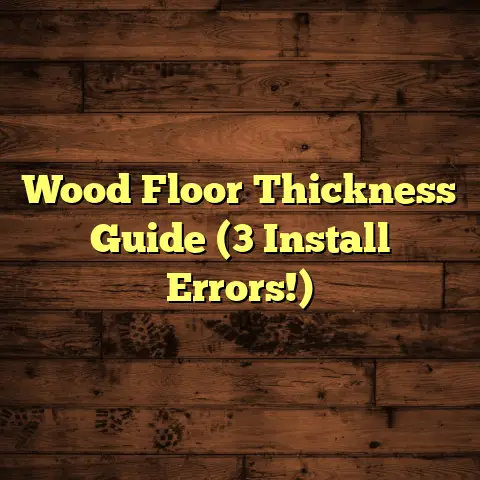Hardwood Boxes For 600 Sq Ft? (1 Mistake Costly!)
Ever get that itch to create something beautiful, something lasting, with your own two hands?
I know I do! And for me, that often leads me back to the timeless art of crafting hardwood boxes.
From a simple keepsake box to a more complex storage solution, there’s something deeply satisfying about transforming raw wood into a functional and visually stunning piece.
But let me tell you, this journey isn’t always smooth sailing. There’s one particular mistake that can turn your dream project into a frustrating (and expensive!) nightmare, especially when you’re dealing with a specific area, like trying to fit boxes into a 600 sq ft space.
So, grab your favorite beverage, settle in, and let’s dive into the wonderful world of hardwood boxes, the craftsmanship behind them, and how to avoid that one costly blunder.
Section 1: Understanding Hardwood Boxes
Okay, so what exactly is a hardwood box?
Simply put, it’s a container made primarily from hardwood – wood sourced from deciduous trees (trees that lose their leaves annually).
Think oak, maple, cherry, walnut – these are your heavy hitters in the hardwood world.
These boxes can serve a multitude of purposes.
I’ve seen them used for:
-
Storage: From jewelry and watches to important documents and family heirlooms.
-
Decorative Pieces: Adding a touch of warmth and sophistication to any room.
-
Gift-Giving: A personalized, handcrafted box makes a truly special and memorable gift.
-
Organization: Custom-built boxes can be designed to perfectly fit specific spaces, maximizing storage and minimizing clutter.
Now, why choose hardwood over, say, softwood (like pine or fir) or even plastic? The answer lies in the unique properties of hardwood:
-
Durability: Hardwoods are denser and more resistant to wear and tear. They can withstand years of use without showing significant signs of damage. I’ve personally seen antique oak boxes that are still going strong after centuries!
-
Aesthetic Appeal: The grain patterns and natural colors of hardwood are simply gorgeous. Each piece is unique, adding character and warmth to any space. You just can’t replicate that with synthetic materials.
-
Sustainability (When Sourced Responsibly): Hardwood can be a sustainable choice if you opt for woods that are certified by organizations like the Forest Stewardship Council (FSC). These certifications ensure that the wood is harvested in an environmentally responsible and socially beneficial manner.
Think about it – a well-crafted hardwood box isn’t just a container; it’s an investment. It’s a piece of art, a functional object, and a potential heirloom all rolled into one.
Section 2: The Importance of Accurate Measurements
Alright, let’s get down to brass tacks.
We’re talking about fitting hardwood boxes into a specific area – in this case, 600 sq ft.
Why is accurate measurement so crucial?
Well, imagine you’re designing a set of custom shelves for your living room. You meticulously measure the wall space, plan out the dimensions of each shelf, and then… you realize you’re off by a few inches.
Suddenly, your shelves don’t fit, your design is compromised, and you’re left with a pile of expensive hardwood that’s essentially useless.
The same principle applies to hardwood boxes, especially when you’re trying to maximize space in a limited area. Accurate measurements directly influence:
-
Design: The size and shape of your boxes will be dictated by the available space. Accurate measurements allow you to create boxes that are both functional and aesthetically pleasing.
-
Functionality: If your boxes are too big, they won’t fit. If they’re too small, they won’t hold what you need them to hold. It’s all about finding that sweet spot.
-
Efficiency: Accurate measurements minimize waste. You’ll know exactly how much wood you need, reducing the risk of overbuying and ending up with leftover scraps.
So, what are some common measurement mistakes that people make? I’ve seen it all:
-
Using the Wrong Tools: A flimsy tape measure or a dull pencil can lead to inaccurate readings. Invest in quality measuring tools.
-
Not Measuring Multiple Times: Always measure at least twice to ensure accuracy. I personally measure three times and take the average, especially for critical dimensions.
-
Ignoring Obstacles: Don’t forget to account for things like baseboards, electrical outlets, and pipes. These seemingly small details can throw off your measurements.
-
Failing to Account for Wood Thickness: This is a big one, and it leads us directly to…
Section 3: The Costly Mistake Explained
Here it is, folks – the mistake that can single- handedly derail your hardwood box project and leave you with a lighter wallet: failing to account for the thickness of the wood when calculating the overall dimensions of your boxes.
Let me explain.
Imagine you’re building a box that needs to be exactly 12 inches wide on the inside. You measure out your pieces of wood to be 12 inches each, cut them, and start assembling.
But wait! You’re using ¾ inch thick wood. That means each side of the box will add ¾ inch to the outside dimension.
So, your 12-inch inside box is actually 13.5 inches wide on the outside (¾ inch + ¾ inch = 1.5 inches).
If you’re trying to fit multiple boxes into a specific space, this seemingly small discrepancy can completely throw off your calculations.
I remember one project where a client wanted me to build a set of custom drawers to fit perfectly into an existing cabinet. He had measured the inside dimensions of the cabinet and provided me with those numbers.
I, being the meticulous contractor that I am, asked him about the thickness of the drawer fronts. He hadn’t considered it!
If I had built the drawers to his initial specifications, they would have been too wide to fit into the cabinet. We would have had to either rebuild the drawers (at his expense) or modify the cabinet (which he didn’t want to do).
That simple oversight could have cost him hundreds of dollars in wasted materials and labor.
Here’s another example:
Let’s say you’re building a set of three identical boxes to fit side-by-side on a shelf that’s exactly 36 inches wide. You want each box to be 12 inches wide, right?
Not so fast. If you’re using ¾ inch thick wood, each box will actually be 13.5 inches wide on the outside. Three boxes at 13.5 inches each equals 40.5 inches – 4.5 inches too wide to fit on your shelf!
The Impact:
-
Wasted Materials: You’ll have to buy more wood to correct your mistakes.
-
Increased Labor Costs: Rebuilding boxes takes time and effort. If you’re paying someone else to do the work, you’ll be racking up the hourly charges.
-
Project Delays: Mistakes can push back your deadlines and disrupt your schedule.
-
Frustration and Disappointment: Let’s be honest, making mistakes is never fun, especially when they could have been avoided.
How to Avoid This Mistake:
-
Always Account for Wood Thickness: Before you start cutting, carefully consider the thickness of the wood you’re using and how it will affect the overall dimensions of your boxes.
-
Create a Detailed Cutting List: A cutting list is a list of all the pieces of wood you need to cut, along with their exact dimensions. Be sure to include the wood thickness in your calculations.
-
Double-Check Your Math: Use a calculator or spreadsheet to verify your measurements. It’s better to be safe than sorry.
-
Build a Prototype: If you’re unsure about your measurements, build a small-scale prototype out of scrap wood. This will allow you to test your design and identify any potential problems before you commit to using expensive hardwood.
Section 4: Craftsmanship in Action
Okay, so we’ve talked about the importance of accurate measurements and how to avoid costly mistakes. Now, let’s take a step back and appreciate the craftsmanship that goes into creating beautiful hardwood boxes.
For me, it all starts with a vision. I might sketch out a design on paper, or I might simply visualize the finished product in my mind.
Then, I move on to selecting the right type of wood. Each hardwood has its own unique characteristics, and the choice depends on the desired look, feel, and functionality of the box.
Once I’ve chosen my wood, I begin the process of cutting the pieces to the exact dimensions specified in my cutting list. This is where precision is paramount. A slight error in cutting can throw off the entire project.
Next comes the joinery. This is the process of connecting the pieces of wood together to form the box. There are many different joinery techniques, each with its own strengths and weaknesses.
Some common joinery methods include:
-
Butt Joints: The simplest type of joint, where two pieces of wood are simply butted together and fastened with screws or nails.
-
Rabbet Joints: A rabbet is a groove cut into the edge of a piece of wood. Rabbet joints are stronger than butt joints and provide a clean, professional look.
-
Dado Joints: A dado is a groove cut into the face of a piece of wood. Dado joints are often used to join shelves to the sides of a cabinet.
-
Dovetail Joints: One of the strongest and most beautiful types of joints. Dovetail joints are characterized by their interlocking “tails” and “pins.”
After the joinery is complete, I move on to sanding. This is a crucial step in preparing the wood for finishing. I start with a coarse grit sandpaper and gradually work my way up to a finer grit, until the surface is smooth and even.
Finally, it’s time for finishing. This is where the true beauty of the wood shines through. I might apply a stain to enhance the natural color of the wood, or I might simply apply a clear coat to protect the surface and bring out the grain.
The finishing process can involve multiple coats of finish, each carefully applied and allowed to dry completely before the next coat is applied.
“The key to good craftsmanship is patience and attention to detail,” says master woodworker David Marks. “Don’t rush the process. Take your time and do it right.”
I couldn’t agree more. Craftsmanship is about more than just skill; it’s about passion, dedication, and a commitment to excellence.
Section 5: Sustainability and Ethical Sourcing
In today’s world, it’s more important than ever to consider the environmental impact of our choices. This is especially true when it comes to woodworking.
Hardwood can be a sustainable choice, but only if it’s sourced responsibly.
What does that mean?
It means choosing woods that are certified by organizations like the Forest Stewardship Council (FSC). FSC certification ensures that the wood is harvested in an environmentally responsible and socially beneficial manner.
It also means avoiding woods that are endangered or threatened. Some hardwoods, like certain types of mahogany and rosewood, are overharvested and are at risk of extinction.
When sourcing hardwood, ask your supplier about the origin of the wood and whether it’s certified sustainable.
You can also look for artisans and companies that prioritize sustainable practices in their woodworking. These businesses often use reclaimed wood, which is wood that has been salvaged from old buildings or other sources.
Reclaimed wood is not only environmentally friendly, but it also has a unique character and history that you can’t find in new wood.
“Sustainability is not just a trend; it’s a responsibility,” says furniture designer Laura Grabowski. “As woodworkers, we have a duty to protect our forests and ensure that future generations can enjoy the beauty and benefits of hardwood.”
Section 6: The Market for Hardwood Boxes
The market for hardwood boxes is thriving, driven by a growing appreciation for handcrafted goods and a desire for unique, personalized items.
Consumers are increasingly willing to pay a premium for quality craftsmanship and sustainable materials.
Trends in hardwood box design include:
-
Minimalism: Clean lines, simple shapes, and a focus on the natural beauty of the wood.
-
Personalization: Custom engraving, unique hardware, and personalized designs.
-
Functionality: Boxes that are designed to serve a specific purpose, such as storing jewelry, organizing office supplies, or displaying collectibles.
When purchasing a hardwood box, consider the following factors:
-
Quality of Materials: Is the wood solid hardwood, or is it a veneer over particleboard? Solid hardwood will be more durable and will last longer.
-
Craftsmanship: Are the joints tight and well-fitted? Is the finish smooth and even? Look for signs of attention to detail.
-
Sustainability: Was the wood sourced responsibly? Look for FSC certification or reclaimed wood.
-
Price: Handmade hardwood boxes will typically cost more than mass-produced boxes. However, the investment is worth it for the quality, durability, and unique character of a handcrafted piece.
Handmade vs. Mass-Produced:
-
Handmade:
- Higher quality materials
- Superior craftsmanship
- Unique designs
- Sustainable sourcing
- Higher price
-
Mass-Produced:
- Lower quality materials
- Inferior craftsmanship
- Generic designs
- Often unsustainable sourcing
- Lower price
Investing in quality craftsmanship is an investment in the future. A well-made hardwood box can last for generations, becoming a cherished heirloom.
Section 7: Maintenance and Care
Once you’ve acquired a beautiful hardwood box, it’s important to take care of it to ensure its longevity.
Here are some tips for maintaining and caring for your hardwood box:
-
Dust Regularly: Use a soft cloth to dust your box regularly. Avoid using harsh chemicals or abrasive cleaners.
-
Avoid Direct Sunlight: Prolonged exposure to direct sunlight can fade the finish and dry out the wood.
-
Control Humidity: Extreme changes in humidity can cause the wood to warp or crack. Keep your box in a stable environment.
-
Protect from Scratches: Use felt pads on the bottom of the box to prevent scratches on furniture.
-
Repair Damage Promptly: If your box gets scratched or damaged, repair it promptly to prevent further damage.
Common issues that can arise with hardwood over time include:
-
Scratches: Scratches can be repaired with a scratch repair pen or by refinishing the surface.
-
Dents: Dents can be removed by steaming the wood.
-
Cracks: Cracks can be repaired with wood filler or by replacing the damaged piece of wood.
-
Fading: Fading can be prevented by avoiding direct sunlight and by applying a UV-resistant finish.
Regular maintenance is essential for preserving the craftsmanship and beauty of your hardwood box.
Conclusion
So, there you have it – a comprehensive guide to hardwood boxes, from understanding their unique properties to avoiding that one costly mistake.
Remember, crafting beautiful hardwood boxes is a labor of love. It requires patience, skill, and a commitment to quality.
By paying attention to detail, sourcing materials responsibly, and taking proper care of your creations, you can create pieces that will be cherished for generations to come.
And most importantly, don’t forget to account for the thickness of the wood! Trust me, your wallet will thank you.
Now go forth and create! I hope this article has inspired you to explore the world of hardwood boxes, whether for personal projects or as beautiful gifts. Happy woodworking!





